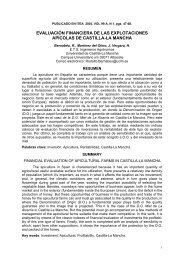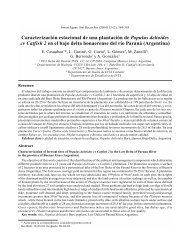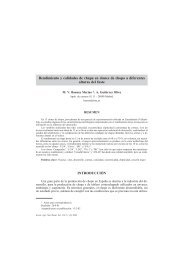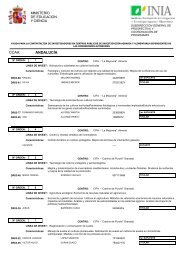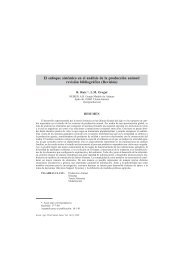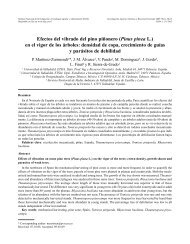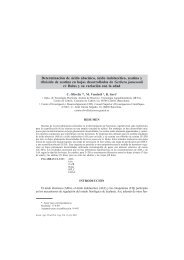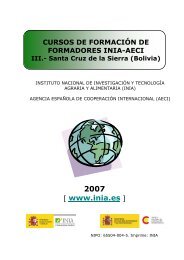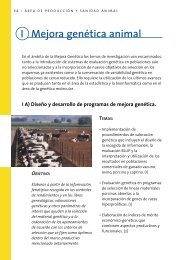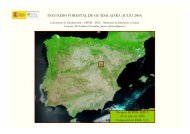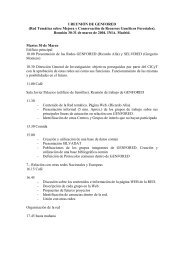Status of medicinal and aromatic plants in - Inia
Status of medicinal and aromatic plants in - Inia
Status of medicinal and aromatic plants in - Inia
Create successful ePaper yourself
Turn your PDF publications into a flip-book with our unique Google optimized e-Paper software.
PRESENTED PAPERS 77<br />
• The collect<strong>in</strong>g <strong>of</strong> Arctostaphylos uva-ursi raw material <strong>in</strong>creased <strong>in</strong> former military areas<br />
where populations <strong>of</strong> high vitality have been observed. In other locations the collect<strong>in</strong>g<br />
<strong>of</strong> raw material seriously damages the st<strong>and</strong>s <strong>of</strong> this plant.<br />
• Centaurium erythraea is native to oceanic Europe <strong>and</strong> the Mediterranean, western Asia<br />
<strong>and</strong> northern Africa, <strong>and</strong> naturalized <strong>in</strong> North America. It is one <strong>of</strong> the traditional<br />
panaceas. Wild populations <strong>of</strong> centaury fluctuate greatly <strong>in</strong> size <strong>and</strong> are short-lived.<br />
They are greatly endangered by collect<strong>in</strong>g <strong>and</strong> destruction <strong>of</strong> natural habitats. The<br />
fluctuations are due to the limited competitive ability <strong>of</strong> the plant <strong>and</strong> depend highly<br />
upon the environment (Radušienė 1995). Several attempts have been made to cultivate<br />
centaury, but the results were unsatisfactory.<br />
• It was revealed recently that sources <strong>of</strong> the widespread species Menyanthes trifoliata<br />
have decreased significantly <strong>of</strong> late. The vitality <strong>of</strong> this plant <strong>in</strong> most st<strong>and</strong>s is moderate<br />
or low. This fact <strong>in</strong>dicates changes <strong>in</strong> moist habitat conditions that threaten the<br />
populations <strong>of</strong> Menyanthes trifoliata.<br />
• Origanum vulgare, <strong>in</strong> spite <strong>of</strong> its economic importance, is <strong>of</strong>ten referred to as an<br />
underutilized taxon, <strong>in</strong> the sense that its genetic resources <strong>and</strong> variability have not yet<br />
been fully explored (Padulosi 1997). The research on germplasm conservation is very<br />
limited outside the Mediterranean region where most resources <strong>of</strong> oregano are<br />
concentrated. The whole genepool <strong>of</strong> oregano should be conserved to have a<br />
representation <strong>of</strong> the diversity <strong>of</strong> this species. The populations <strong>of</strong> oregano <strong>in</strong> Lithuania<br />
are characterized by a limited distribution <strong>and</strong> low sources <strong>of</strong> raw material. The majority<br />
<strong>of</strong> populations are concentrated <strong>in</strong> southeast <strong>and</strong> east Lithuania (Fig. 4). The <strong>in</strong>itial step<br />
<strong>of</strong> conservation <strong>of</strong> oregano consisted <strong>in</strong> identification <strong>of</strong> grow<strong>in</strong>g sites, gather<strong>in</strong>g <strong>of</strong> wild<br />
accessions, their characterization <strong>and</strong> <strong>in</strong>troduction <strong>in</strong>to the field, further evaluation <strong>and</strong><br />
multiplication <strong>of</strong> the selected material.<br />
Fig. 4. Distribution <strong>of</strong> Origanum vulgare L. <strong>in</strong>digenous populations <strong>in</strong> Lithuania.




